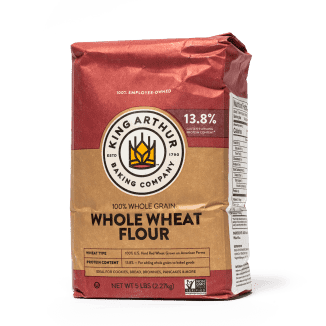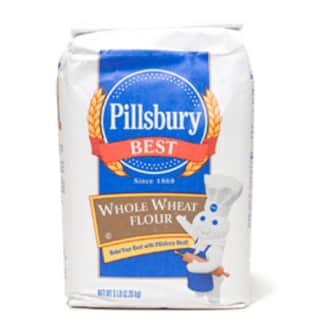Reviews You Can Trust.
See Why.
Whole-Wheat Flour
If you thought all whole-wheat flours are created equal, you were wrong.
Top Pick

WinnerKing Arthur Premium Whole Wheat Flour
Sign up for the Well-Equipped Cook newsletter
Shop smarter with our ATK Reviews team's expert guides and recommendations.
What You Need to Know
Unlike refined white flour, which is derived from just the grain’s stripped-down inner core, or endosperm, whole-wheat flour is made from the entire wheat berry: endosperm, germ, and bran. Because of this, it boasts a brown color and more pronounced wheat flavor. To see if there was any difference from bag to bag, we chose five brands, working them into our recipes for whole-wheat sandwich bread and pancakes.
Before the breads even reached the oven, we noticed that the dough made with one whole-wheat flour was loose and sticky and more difficult to handle. Once baked, the loaf crumbled in hand, though tasters praised its “bold,” “unapologetic” wheat flavor. At the other extreme, the breads made with our two least favorite whole-wheat flours had overly soft textures. Tasters also criticized their flavors for being “muted”; some even went so far as to say that one loaf could practically have passed for white bread. These results more or less tracked with the pancakes, too: The wheat flavor from these latter two brands was relatively underwhelming, while the flapjacks from two of our favorites were robustly flavored. Only one brand had it all, earning praise for a “sweet,” “nutty” flavor, tender, airy pancakes, and bread with just the right soft yet hearty crumb.
Hoping to explain why the flours performed differently, we started by dumping a sample from each bag into a bowl and running our hands through it. One of our flours stood apart, with grains that resembled tiny flakes, whereas the other flours felt finer and more powdery. When we examined its label, we learned that this particular flour is a graham flour, the coarsest type of flour available. The other four flours were either stone-ground or steel-rolled into much finer particles and felt almost identical.
The Whole (Grain) Truth
It made sense that the coarsest flour produced a denser, more crumbly loaf. Bread texture is directly related to the development of gluten, the network of proteins that give it lift and structure. But the gluten-producing proteins in flour exist only in the endosperm, not in the germ or the bran that also make up whole-grain flour. In fact, the bran contains sharp edges that shred the strands of gluten that develops in dough, thereby allowing air to escape. The bigger pieces of bran in a coarser grind only exacerbate this effect, creating a loaf with less structure and a denser crumb.
That explained why the graham flour loaf turned out the way it did. But we still didn’t understand why our favorite flour produced a heartier texture than the three other brands when the grind size of each looked and felt very similar. We were also still curious about why the graham flour pancakes were tender when the corresponding loaf was coarse and crumbly. So we dug around for additional clues and made two other key discoveries.
First, there was the type of wheat used: Four of the five flours we tasted were ground from hard red wheat, whereas the graham flour combined both hard and soft red wheats. Further research revealed that hard red wheat produces stronger gluten networks and is therefore a good choice for yeast-leavened baked goods like bread. Soft red wheat, on the other hand, is known for producing a tender texture in baked goods that use chemical leaveners—including pancakes.
Second, there was the quality of the wheat itself. If a wheat berry is allowed to germinate (or sprout), it produces an enzyme that makes dough sticky and less prone to rising. A representative from one company told us that to measure wheat quality, manufacturers perform a “falling number” test, in which a plunger is sent to the bottom of a test tube filled with a hot paste of wheat meal and water. The longer it takes for the plunger to fall, the higher the quality of the wheat and the lower the amount of the enzyme amylase. Our runner-up flour reported that the company looks for a falling number score of at least five minutes. Our winner surpasses this minimum: According to the company, its whole-wheat flour must achieve a falling number score closer to 10 minutes. We can only assume that there’s always a correlation between good-quality wheat and demanding a relatively high falling number: None of the other flour producers would provide information about their requirements.
Bottom line: Our winner is the best bet for those seeking an all-purpose whole-wheat flour. For those who want more wheaty punch—and don’t mind a crumbly loaf—the graham flour makes a good alternative.
America's Test KitchenWatch Now
Everything We Tested
Recommended

WinnerKing Arthur Premium Whole Wheat Flour

Bob’s Red Mill Organic Whole Wheat Flour
Recommended with reservations

Hodgson Mill Old Fashioned Whole Wheat Four

Gold Medal Whole Wheat Flour

Pillsbury Best Whole Wheat Flour
*All products reviewed by America’s Test Kitchen are independently chosen, researched, and reviewed by our editors. We buy products for testing at retail locations and do not accept unsolicited samples for testing. We list suggested sources for recommended products as a convenience to our readers but do not endorse specific retailers. When you choose to purchase our editorial recommendations from the links we provide, we may earn an affiliate commission. Prices are subject to change.
Reviews You Can Trust
The mission of America’s Test Kitchen Reviews is to find the best equipment and ingredients for the home cook through rigorous, hands-on testing. Have a question or suggestion? Send us an email at atkreviews@americastestkitchen.com. We appreciate your feedback!
Reviews You Can Trust.
See Why.


